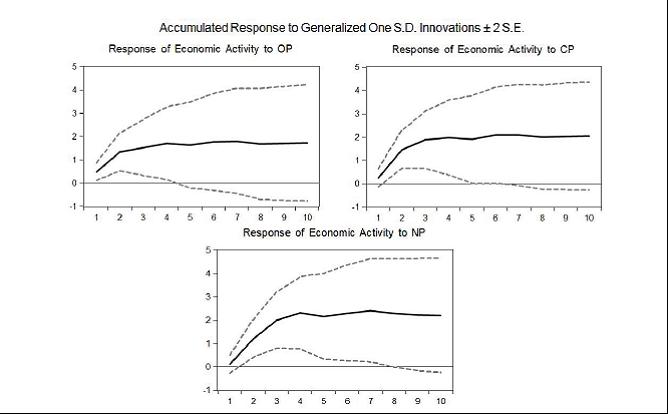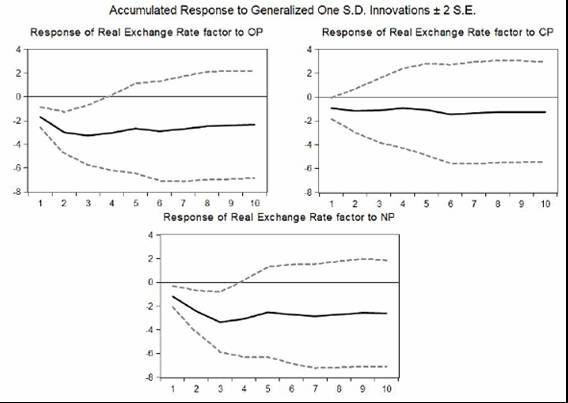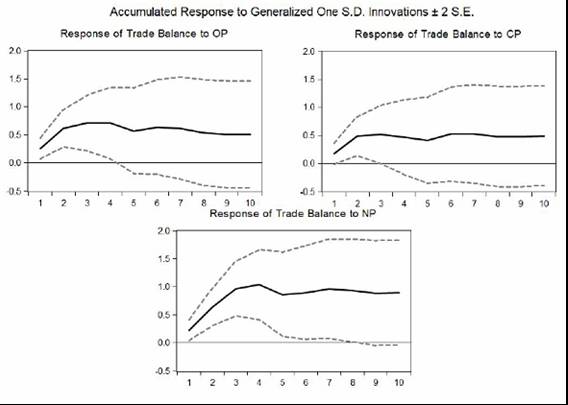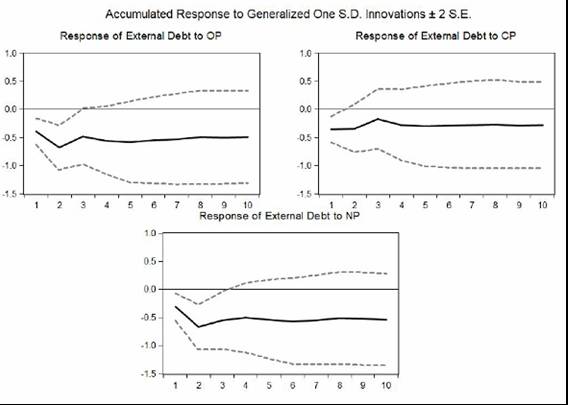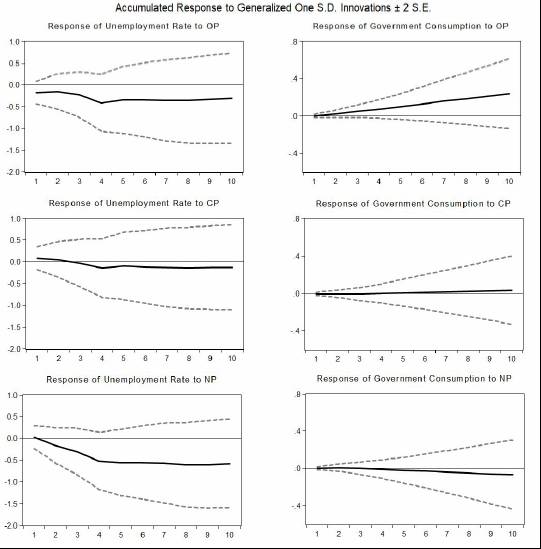1. Introduction
Latin American countries have been characterized by having a high dependence on the production of raw materials in their exports, which has resulted in their economies being exposed to fluctuations generated by the prices of commodities (Castillo and Salas, 2010). The Colombian economy is not immune to these variations, in fact, Jenkins (2011) observed that the increase in the demand for basic goods by Asian countries, between 2001 and 2007, generated an increase in its foreign exchange earnings for Colombia of almost 10%. However, Vargas (2015) explained that the slowdown in demand for raw materials in mid-2008 and the subsequent fall in the price of oil in 2014, produced a reduction in national income, which increased the current account deficit of the balance of payments and caused an unprecedented depreciation of the national currency.
Additionally, for Colombia, fluctuations in the prices of raw materials are of great importance, considering that exports for 2015 represented 15% of GDP (The World Bank Group, 2016) and that 80% of them were basic products, where oil (40%), coal (13%) and nickel (1%) 1 constitute more than half of national exports (Consejo Privado de la Competitividad, 2014). Therefore, it is important to study the effects generated by the prices of the mining-energy products exported by Colombia on economic activity and to determine which are the variables that directly receive this impact.
Given the above, the objective of this research is to evaluate the effects caused by variations in oil, coal and nickel prices on Colombian macroeconomic variables, mainly on production, investment, the trade balance, the exchange rate, and foreign debt. In addition, this paper seeks to provide an alternative analysis to the research carried out by Oviedo and Sierra (2019). The methodology applied in this analysis is called FAVAR (Factor Augmented VAR), developed by Bernanke, Boivin, and Eliasz (2005)). The most outstanding results indicate significant effects on variables such as economic activity, investment, the trade balance, the real exchange rate, and external debt.
The work is divided into the following sections: section 2, reviews the literary references; Section 3 describes the evolution of the prices of exported commodities and their relationship to the economy; Section 4 presents information on the applied empirical methodology; in section 5, a description of the data is made and section 6, discloses the results. Finally, section 7 presents the conclusions.
2. Literature Review
Different international and national studies have shown the importance of variations in raw material prices on economic aggregates, based on the use of the terms of trade 2 (TOT) or oil prices, both in developed and ongoing economies developmental. At the international level, Mendoza (1995) analyzed the effects of the oscillations in the terms of trade on the business cycle for developed and emerging countries. The results show that TOT variations explain GDP fluctuations by 37% in developing countries, while in developed countries they do so by 33%. On the other hand, Fernández, González, and Rodríguez (2015) analyzed the incidence of commodity prices on the economic cycles of emerging countries and found that a positive shock generates positive and significant effects on GDP, investment and consumption and a negative and significant effect on the real exchange rate (RER) index. Meanwhile, Spatafora and Warner (1999) determined for a group of 18 oil exporting countries that the incidence of TOT variations on GDP, consumption and investment is 30%. However, Schmitt-Grohé and Uribe (2015) analyzed the effects of TOT for 38 emerging economies and found that the variations affect production, consumption and investment by 10%.
On the other hand, fluctuations in the prices of raw materials affect not only the prices of industrial products (Regnier, 2007), but also generate variations in the use of production factors, mainly at work, thanks to the intensity in the use of labor and capital (Hamilton, 1988; Bretschger, 2015; Lee and Ni, 2002), which influences the competitiveness of the sectors that produce tradable goods in the international market. Therefore, the shocks of commodity prices can generate involuntary unemployment in sectors that lose competitiveness due to the inflow of foreign currency (Hamilton, 1988; Lilien, 1982).
For its part, Latin America has been characterized by a high dependence on the production of raw materials for export, so much so that by 2014, total exports of these products exceeded 60% in the whole southern region of the continent. Medina (2010) identified that a commodity price shock produces a significant and positive impact on government consumption, which extents 3 quarters on the Latin American economies. While, Ben-Zeev, Pappa, and Vicondoa (2016), identified that TOT generates, approximately, 25% of the fluctuations of the production of Brazil, Mexico, Chile, Colombia, Ecuador, Argentina, and Peru. Similarly, at the country level, Castillo and Salas (2010) for Peru and Peña (2008, 2015) for Venezuela, found that increases in raw material prices affect variables such as GDP, employment rate, consumption, and investment.
At the Colombian level, several studies have shown the effects of variations in the prices of commodities and oil on variables such as production, investment, the real exchange rate, or inflation. Oviedo and Sierra (2019), based on a FAVAR model, determined that TOT variations generate an increase in economic activity and the trade balance and a decrease in the real exchange rate. However, they observed that the investment presented an equivalent variation of 8% due to a positive fluctuation in the prices of raw materials. On the other hand, and in line with the results described above, Hernández (2013) evaluated the fluctuations of TOT on GDP and concluded that 33% of the quarterly variability of GDP depends on TOT.
On the other hand, and when reviewing the effects of oil prices in Colombia, González and Hernández (2016) identified positive and significant effects on GDP, on the TOT index, on the trade balance, and on foreign direct investment and a negative response from the RER (real appreciation). According to the previous results, Gómez (2015) concludes that a positive oil price shock generates a positive and significant effect on GDP and the CPI, but observes significant negative effects on external public debt. At the regional level, for the department of Valle del Cauca, Candelo (2018) observed, through an Error Correction Vector model (VECM) and a VAR model, that an increase in oil prices causes a slowdown in GDP regional, which deteriorates consumption, due to the high income of foreign remittances in the region. It would be convenient to study the incidence of commodity prices at the local level to understand their economic dynamics and compare the response of regional economic aggregates with the country’s global economic aggregates, in the face of the shocks of these exogenous variables.
Despite the evidence found at the level of empirical studies, this research seeks to give continuity to the study carried out by Oviedo and Sierra (2019), to expand the results found on the impact that variations in commodity prices have on economic activity Colombia, based on the price discrimination of the three mining-energy goods with the greatest weight in national exports.
3. Importance of Commodity Prices on the Economy
As it has been observed, the Colombian economy is characterized by a high dependence on the production of raw materials in its exports, mainly in products belonging to the mining and energy sector. It has been established that, by the year 2015, 40% of exports were oil, 13% coal, 7% coffee and 1% nickel, so it is extremely important to understand the dynamics of the prices of these products over the last decades, because the most relevant effects are captured in economies that concentrate their exports in mineral-energy goods, followed by exporters of other raw materials and manufactured goods, as indicated by Sinnott, Nash, and De la Torre (2010).
Graph 1 describes the production of oil, coffee, coal, and nickel exported annually as a proportion of total national exports, based on the evolution of their prices 3, for the period 1980-2016. In the first place, after analyzing the behavior of the participation and the prices of coffee and oil, it is possible to affirm that these raw materials are the ones with the greatest weight in national exports over the last decades. In fact, since 1970 after the coffee boom in Colombia, coffee became the most important export product, because it represented 50% of total exports (Cano, Vallejo, Caicedo, Amador, and Tique, 2012). However, in the middle of 2000, oil and coal increased their share of exports and have been the most important goods for Colombia. As evidenced, the proportions of these two products have had a constant value for the highest prices achieved, while coffee has presented significant price increases, although the proportion tends to be lower and highly variable. Finally, small increases can be found in the share of nickel over other exports, as its price increases.
In relation to nickel prices, it shows a similar behavior to oil prices. On the one hand, it can be inferred that the dynamics of these prices has been increasing in the middle of 2000, mainly due to the increase in demand for commodities in Asian countries and a subsequent fall at the end of the year.
Graph 1 Exported coffee, coal, oil, and nickel production as a total proportion of exports in Colombia, based on their price for 1980-2016.
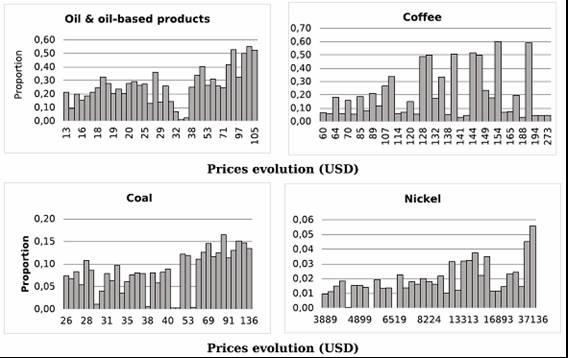
Graph 1 Exported coffee, coal, oil, and nickel production as a total proportion of exports in Colombia, based on their price for 1980-2016. Source: The report is based on data obtained from Banco de la República (2020).
According to authors such as Oviedo and Sierra (2019), Fernández et al. (2015), Medina (2010), and Hernández (2013), who have shown the variations in commodity prices both individually and through the use of the TOT variable, it has been observed that these exogenous shocks generate effects on internal variables such as: GDP, investment, trade balance, RER, inflation, and external debt. Therefore, by observing Table 1, correlations between the prices of mining and energy commodities and the described variables of interest are identified. It can be seen that all prices have a positive relation to GDP, investment, and trade balance and a negative relation to RER, inflation, and foreign debt. Parra (2008) states that commodity shocks, measured through TOT, generate increases in production and investment due to the reallocation of capital to its productive place. In the case of the trade balance, the positive correlation is determined by the fact that the increase in the prices of these products encourages an increase in exports. On the other hand, the present negative relationship with the RER is consistent with the results found by Poncela, Senra, and Sierra (2016) who infer that the income derived, for example, from the increase in the price of oil generates an inflow of foreign currency that causes the real appreciation of the peso against the dollar. Finally, Gil (2016) found that commodity price shocks on Latin American economies do not generate significant effects on inflation and economic growth.
Table 1 Correlations between commodity prices and interest variable
| Variables | GDP | Investment | Trade balance | RER | Inflation | Foreign debt |
|---|---|---|---|---|---|---|
| P. of Oil | 0.62 | 0.64 | 0.81 | -0.88 | -0.66 | -0.45 |
| P. of Coal | 0.52 | 0.54 | 0.72 | -0.82 | -0.49 | -0.44 |
| P. of Nickel | 0.7 | 0.71 | 0.85 | -0.86 | -0.71 | -0.43 |
Source: Authors’ own elaboration.
One of the most common negative effects of rising commodity prices on export economies is Dutch disease. This effect refers to the decrease in non-mining industrial competitiveness due to the fact that domestic products become relatively more expensive due to the devaluation of the dollar, which is the result of strong foreign exchange earnings. However, Poncela et al. (2016) identified for Colombia, that variations in commodity prices produce a currency revaluation, but not an industrial deterioration.
4. Methodology
The following is a description of the empirical methodology applied to identify the effects of price shocks of the three most important commodities on national exports.
4.1. FAVAR Models
The FAVAR Model can be written as the VAR model described by equation [1]:
where the vector Y t , of M×1 dimensions, is constituted by the set of observable economic variables: oil prices, coal prices, nickel prices, production, investment, trade balance, exchange rate, consumption, and inflation, for a t=1,2,…T periods. However, the VAR models exclude additional information that is relevant to interpret the dynamics of the series that constitute the vector. Therefore, the use of the vector F t is required, with K×1 unobservable factors, which summarizes the information that cannot be described by the vector Y t . Additionally, Φ(L) represents the matrix of the finite lag polynomial of order d, and, v t is an error term with zero medium and with a covariance matrix Q.
For the estimation of unobservable factors, the dynamic factorial models proposed by Geweke (1976)) and extensively applied by Stock and Watson (2002, 2005, 2011) are applied. Dynamic factorial models can be statically written by equation [2]:
where X t is a vector of Nx1 dimensions, containing a large set of information. This vector is a function of the sum of two unobservable components: a component common to all variables, F t , and an idiosyncratic component, e t 4, proper to each variable. Whereas, Λ is matrix composed of the factor loads, of dimension N×K, and the term ΛF t is defined as the common components of X t .
The estimation method of the FAVAR model applied in the research consists of finding the factors of the information set X
t
through principal components, and later including the estimated factors
5. Data
The database applied to this research was constructed by Oviedo and Sierra (2019) 5 and is divided into two parts: the first part contains the series of interest such as the prices of mining-energy goods (oil, coal, and nickel), the product, investment, the trade balance, the exchange rate, and external debt. The second part is made up of 129 series that represent different sectors of the Colombian economy. The sectors are described as economic activity (23) 6, external sector (23), the real exchange rate (5), prices (31), monetary aggregates (16), total national employment (6), non-financial public sector (7), foreign investment flows in Colombia (12), and interest rates (6). The choice of the period was determined because it includes the boom in commodity prices in 2002 and its subsequent slowdown in 2008.
The series were reviewed one by one to eliminate atypical data, through the program TRAMO 7 (Gómez and Maravall, 2001) and they were transformed into dummy variables. On the other hand, it was sought that the matrix of variables X t , was stationary.
6. Empirical Results and Discussion
Next, the results are presented from the estimation of the FAVAR model described by equation [1] and proposed by Bernanke et al. (2005). However, and before the results of the model, the estimation of the factors is made known through the methodology developed by Bai and Ng (2002).
6.1. Estimation of the Number of Factors
According to the information criteria of Bai and Ng (2002), it is found that the first two suggested the use of four factors and the third nine. Table 2 describes the results of the three penalty functions IC 1 , IC 2 , IC 3 .
Table 2 Number of estimated factors
| Sample | Period | N° Obs. | IC 1 | IC 2 | IC 3 |
|---|---|---|---|---|---|
| Complete | 2001Q1-2016Q1 | 61 | 4 | 4 | 9 |
Source: Authors’ own elaboration.
The first principal component that describes 18% of the variance proportion is selected as shown in Table 3 and is called the real exchange rate, due to the weight it has on the series 8. The second factor explains about 16% of the variance and is named monetary aggregates, while the third factor, which explains about 13% of the variance, is named prices and the fourth factor, which describes 10%, is named names economic activity. It is indisputable that the first four factors describe almost 57% of the total variance and from the fifth factor, the contribution of each one is lower, close to 5%, which confirms the choice of four factors.
Table 3 Factors found by Principal Component Analysis
| N° of factor | Value | Difference | Proportion | Cumulative Value | Cumulative Proportion |
|---|---|---|---|---|---|
| 1 | 18.117920 | 2.40323 | 0.1342 | 18.11792 | 0.1342 |
| 2 | 15.714690 | 2.41727 | 0.1164 | 33.83262 | 0.2506 |
| 3 | 13.297420 | 3.52985 | 0.0985 | 47.13004 | 0.3491 |
| 4 | 9.767571 | 3.08406 | 0.0724 | 56.89761 | 0.4215 |
| 5 | 6.683512 | 0.945658 | 0.0495 | 63.58112 | 0.4710 |
| 6 | 5.737855 | 0.587268 | 0.0425 | 69.31898 | 0.5135 |
Source: Authors’ own elaboration
6. 2. Impulse Response Functions (IRF)
Next, the estimates IRF 9 are presented from the FAVAR, which was described through the equation [1]. The model is characterized by containing in the vector, Y
t
, the observable variables: oil prices [OP
t
], coal prices [CP
t
], nickel prices [NP
t
], investment [I
t
], trade balance [TB
t
], external debt [ED
t
], unemployment rate [UR
t
], and government consumption [GC
t
]. While the vector
6.3. Impact of Oil, Coal, and Nickel Prices on Economic Activity
Graph 2 shows the response of the economic activity factor to a positive shock in the prices of oil, coal, and nickel. It can be seen the three mining-energy assets generate positive and significant effects on the variable studied, but the duration differs. Oil prices produce economic growth that spans four periods, while coal prices cause an economic improvement observable one quarter after the shock, lasting three quarters. Finally, nickel prices increase economic activity for six quarters, but the effects are generated a period later. Oviedo and Sierra (2019) identified that a positive TOT shock causes an improvement in production that spans four quarters. The increase in the prices of these products increases the entry of foreign currency into the country, which increases the income of the export sector and encourages production. On the other hand, Parra (2008) explains that production increases thanks to an improvement in the income of the export sector.
6.4. Impact of Oil, Coal, and, Nickel Prices on Investment
Oviedo and Sierra (2019) indicated that the positive variation in investment occurs indirectly through fluctuations in the trade balance, which causes increases in income, and these in turn on investment. Graph 3 shows that investment responds positively and significantly to increases in the price of oil, however, the innovations in the prices of coal and nickel generate non-significant responses because the extraction of these minerals is not intensive in the capital.
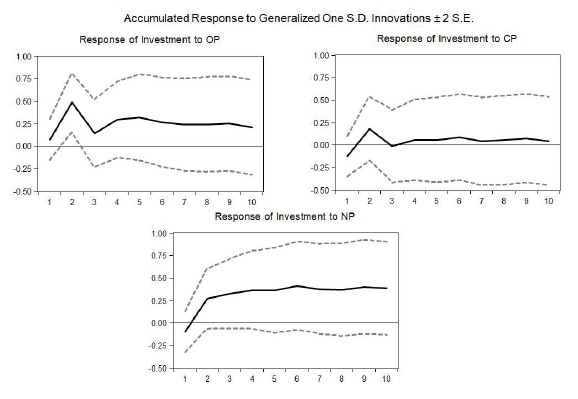
Graph 3 Investment response to a positive shock in oil, coal, and nickel prices. Source: Authors’own elaboration.
The response spans a quarter and occurs in a post-shock period. The increase in income from the export sector generates incentives to request credits, after observing the increase in the mining-energy good price which translates into an increase in investment.
6.5. Impact of Oil, Coal and Nickel Prices on the Real Exchange Rate
The graph 4 allows us to observe that the RER presents a negative and significant response, with an approximate duration of three quarters from the shock. The effect that is generated is related to the high flow of foreign currency that enters, which appreciates the national currency. Oviedo and Sierra (2019) explain that the increase in the prices of exported goods creates an appreciation of the Colombian currency in the short term and the effect received by the sector benefiting from the boom is a function of its exposure to external markets and the composition of its inputs, both national and imported.
6.6. Impact of Oil, Coal, and Nickel Prices on the Trade Balance
The trade balance reacts significantly and positively to the increases in the prices of the three mining-energy goods, with a duration that extends for more than three quarters, as can be seen in Graph 5. The increase in the prices of exported products increases the national production of exported goods, that is to say, there is an increase in exports.
6.7. Impact of Oil, Coal, and Nickel Prices on External Debt
The graph 6 shows that foreign debt reacts significantly and negatively to the positive shocks of oil, coal, and nickel prices. The response spans approximately three quarters from the time the innovation is first introduced. This can be explained by the relationship between the external debt and the trade balance because the increase in exports reduces the trade balance deficit, which reduces the intentional indebtedness. It is also possible to deduce that, after the depreciation of the international currency, private companies, and the public sector decrease the number of their foreign debts.
6.8. Impact of Oil, Coal, and Nickel Prices on the Unemployment Rate and Government Consumption
The graphic 7, shows that the shocks caused by the prices of energy mining goods do not generate significant effects on the unemployment rate and government consumption. In the first place, the Colombian economy, having a strong dependence on oil production, receives high income through price increases, but these do not represent improvements in social development and mainly, they are not job generators given the inefficiency in the expense. Borge, Parmer, and Torvik (2015) explain that the increase in income from the exploitation of natural resources is associated with the inefficiency in spending and unemployment and a low level of economic growth is observed despite a high level of tax revenue generated by the mining-energy sector. For their part, Villar, Castro, Forero, Ramírez, and Reina (2014) describe, based on the construction of an input-product matrix, that the productive chains of the oil sector are not very significant and are visible, exclusively, in the same extractive sector, which shows the low incidence in the creation of employment in this sector, through intermediate consumption in other sectors. Second, the response of government consumption tends to be positive, but its impact is not statistically significant, because the government tends to save part of the income in cyclical moments where the price of oil reaches high levels so that in subsequent periods generate the effect of spending or dissaving (Perilla, 2010).
6.9. Variance Decomposition
Table 4 shows the variance decomposition 10 where the percentage of variation generated by the fluctuations in the prices of the three raw materials studied on the economic aggregates is identified, for a finite horizon of 20 periods. The economic activity presented a variation between 1.9% and 7.6% due to fluctuations in commodities prices. On the other hand, investment shows variations between 4.0% and 10%, while the exchange rate shows oscillations between 1.4% and 7.9%. For its part, the trade balance varies between 1.8% and 6.9%, the external debt between 12.5% and 14.3%, the unemployment rate between 3.1% and 6%, and government consumption between 1.1% and 4.6%.
Table 4 Variance Decomposition of the Selected Variables of Interest
| Percentage of the variance explained by the prices of: | |||
|---|---|---|---|
| Variables | Oil | Coal | Nickel |
| Economic Activity (GDP) | 7.6 | 4.0 | 1.9 |
| Invesment | 5.4 | 4.0 | 10.2 |
| Real Exchange Rate | 7.9 | 2.0 | 1.4 |
| Trade Balance | 6.9 | 1.8 | 3.1 |
| External Debt | 13.9 | 14.3 | 12.5 |
| Unemployment Rate | 6.0 | 3.1 | 3.1 |
| Government Consumption | 4.6 | 2.9 | 1.1 |
Source: Authors’ own elaboration.
Most of the fluctuations in the economic aggregates observed are due to the behavior of oil prices, because of their great weight in national exports. The variables with the greatest fluctuation are economic activity, investment, the real exchange rate, trade trivialization, and foreign debt. Oviedo and Sierra (2019) found that investment was the variable that received the greatest amount of shock because of the improvement in the prices of exported goods improves the marginal profitability of the export sector. Also, it is observed that the external debt presents a significant decrease for each increase in the prices of these products, giving rise to an improvement in the benefits in the indebted sectors.
7. Conclusions
The main objective of this research was to evaluate the effects of the variations in the prices of mining and energy goods, with greater weight in Colombian exports, on the different economic aggregates. Also, it sought to give continuity to the study carried out by Oviedo and Sierra (2019), which made it possible to understand the incidents that TOT has on Colombian economic activity.
The impacts generated on the economy allow to conclude that a rise in the prices of these products generates an increase in the activity of the national economy and in investment, which is mostly focused on the oil sector due to its profitability, consequently, there is an increase in national exports, which reduces the trade deficit and, as a result, reduces the external debt. On the other hand, the boom in the commodities sector produces a revaluation of the Colombian peso because the increase in foreign currency inflows due to the dynamism of the mining-energy sector. In addition, this research shows indications that there is not a great benefit on the activity of the mining sector and on other indicators such as the unemployment rate and government consumption, which are fundamental for the improvement of the well-being of an economy. It is important to clarify that developing economies tend to generate a high dependence on the income of oil and / or other extractive mining-energy products, but the increase in spending does not imply improvements in employment or social investment, because the sector has a reduced demand for labor and even though the evidence does not show industrial deterioration due to Dutch disease, the economies that base their development on the production of these products tend to have low levels of growth despite tax revenues from the petroleum.
The foregoing raises some questions about the targeting of the resources generated by this sector, because, and although an improvement in the economy is evident at the aggregate level, there are no positive effects on fundamental variables, which contribute to sectors such as the manufacturing industry and the services sector, which are intensive in labor and capital, which would allow economic growth with less dependence on variables exogenous to the system.














